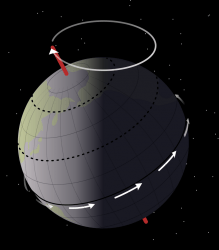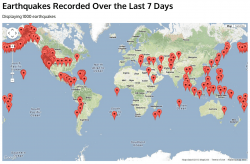I’m going to ask you how long a day is on Earth, and you’re going to get the haunting suspicion that this is a trap. Your instincts are right, it’s a trap! The answer may surprise you.
How long is a day on Earth? Or more specifically, how long does it take for the Earth to turn once on its axis? For all the stars to move through the sky and return to their original position? Go ahead, and yell your answer answer at the screen… 24 hours?
Wrong! It only takes 23 hours, 56 minutes and 4.0916 seconds for the Earth to turn once its axis. Unless that’s what you said. In which case, congratulations!
I’m sure you’re now stumbling around in an incoherent state, trying to understand how you could have possibly messed this up. Were you reprogrammed by the hidden chronology conspiracy? Have time travellers been setting back all your clocks every day by 4 minutes? How was your whole life a lie?
Here’s the deal. When you consider a day, you’re probably thinking of your trusty clock, or maybe that smartphone lock screen that clearly measures 24 hours.
What you have come to understand as a “day” is classified by astronomers as a solar day. It’s the amount of time it takes for the Sun to move through the sky and return to roughly the same spot.
This is different from the amount of time it takes for the Earth to turn once on its axis – the 23 hours, 56 minutes. Also known as a sidereal day.
Why are these two numbers different? Imagine the Earth orbiting the Sun, taking a full 365 days, 5 hours, 48 minutes and 46 seconds to complete the entire journey. At the same time, the Earth is spinning on its axis.
Each day that goes by, the Earth needs to turn a little further for the Sun to return to the same place in the sky.… And that extra time is about 4 minutes.
If we only measured sidereal days, the position of the Sun would slip back, day after day. For half of the year, the Sun would be up between 12am and 12pm, and for the other half, it would be between 12pm and 12am. There would be no connection between what time it is, and whether or not the Sun is in the sky.

Can you imagine teaching your children how to read a clock, and then getting them to multiply that by the calendar to figure out when My Little Pony: Friendship is Magic starts? Madness.
Better to keep them in the dark, teach them that a day is 24 hours, and deny all knowledge when they get a little older, and start to ask you challenging questions. But pedants among you already knew that, didn’t you?
You already knew that a sidereal day is a little shorter than a solar day, and that everyone else has been living a lie. You’re the only one who can read the signs and know the terrifying truth. Aren’t you? Well, I’m here to tell you that you’re wrong too. There’s a deeper conspiracy that you’re not a part of. Dear Pedant, your life is also a lie.
The axis of the Earth’s pole, the imaginary line that you could draw between the south pole and the north pole is currently pointed roughly at Polaris, aka The North Star. But we’re wobbling like a top, and where the axis is pointing is slowly precessing westward over the course of 26,000 years. This means that a sidereal day is actually 0.0084 seconds shorter when you account for this extra movement of the Earth’s axis.

There are other events that can increase or decrease the length of an Earth day. Because of our tidal interactions with the Moon, the length of a day on Earth has increased by about 1.7 milliseconds over the last 100 years. Powerful earthquakes can change the Earth’s rotation time by a few microseconds depending on how the tectonic plates shove around. Even as the glaciers melt, the rotation speed slows down a little more.
So, if someone asks you how long a day is, make sure they clarify whether it’s a solar day or a sidereal day. And then ask if they’d like you to incorporate the Earth’s precession, tidal locking and recent earthquakes into the calculation.
If they give you a knowing nod, congratulations, you’re talking to another member of the vast chronology conspiracy.
When did you discover your whole life was a lie? Tell us in the comments below.


